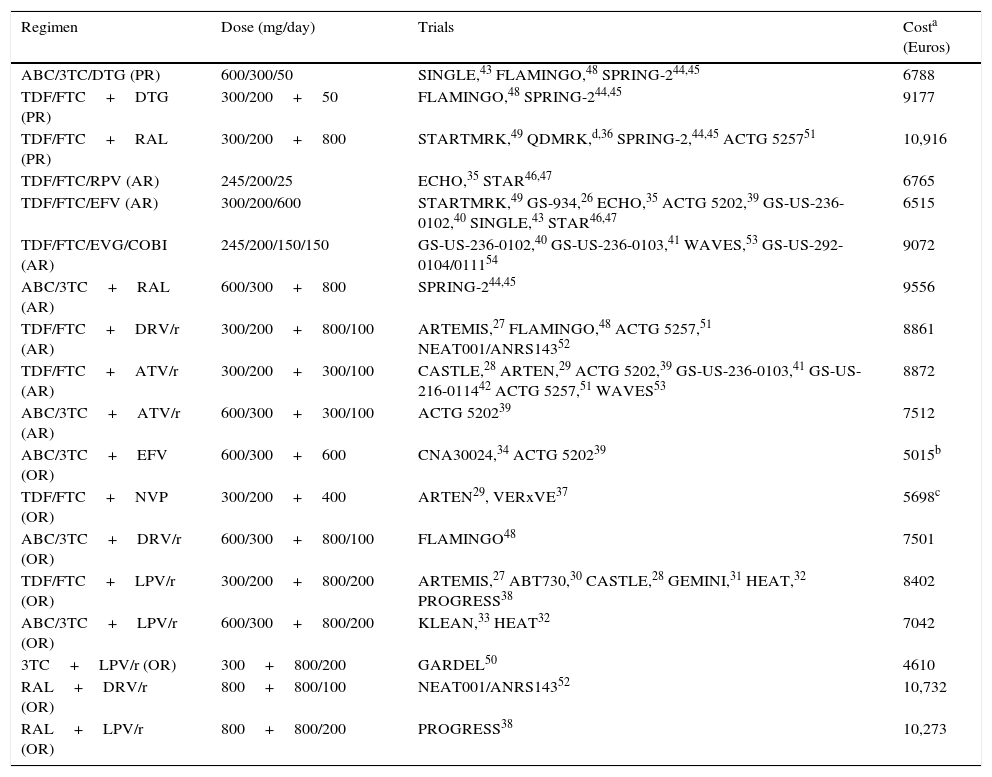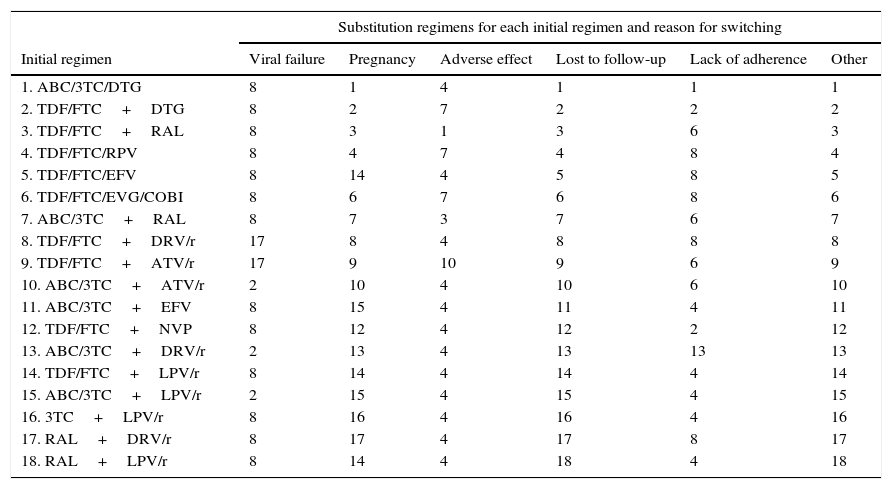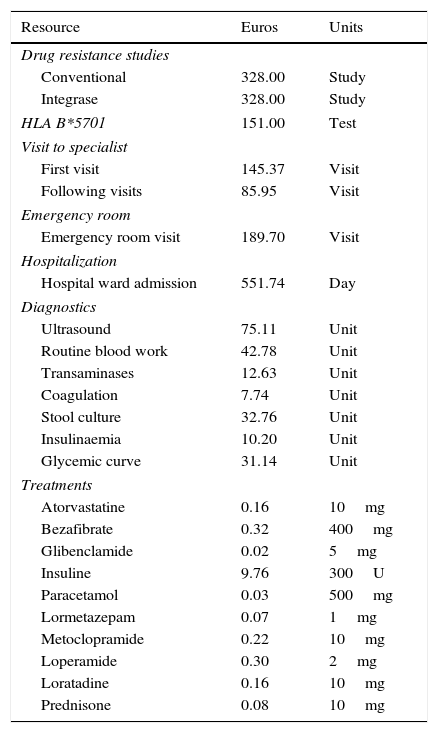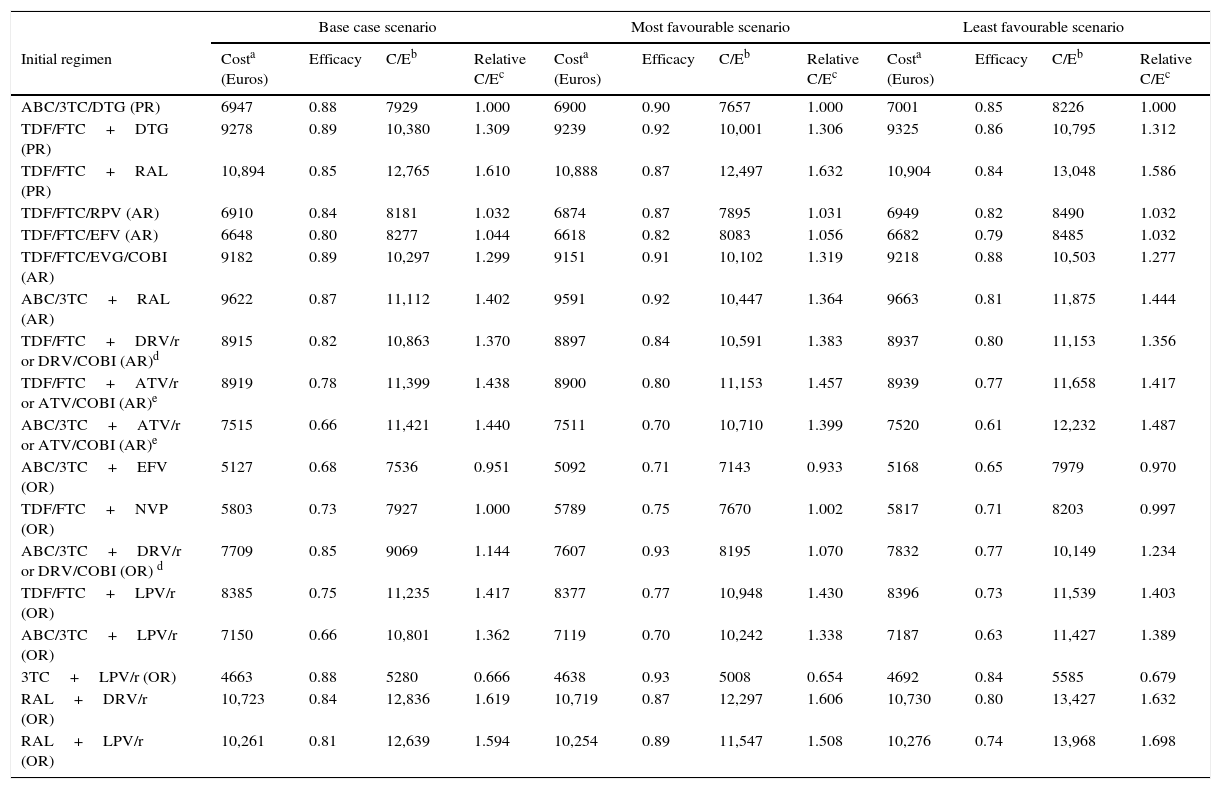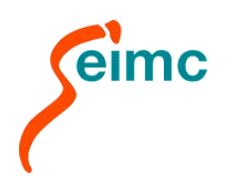GESIDA and the AIDS National Plan panel of experts suggest preferred (PR), alternative (AR), and other regimens (OR) for antiretroviral treatment (ART) as initial therapy in HIV-infected patients for the year 2016. The objective of this study is to evaluate the costs and the efficacy of initiating treatment with these regimens.
MethodsEconomic assessment of costs and efficiency (cost/efficacy) based on decision tree analyses. Efficacy was defined as the probability of reporting a viral load <50copies/mL at week 48 in an intention-to-treat analysis. Cost of initiating treatment with an ART regimen was defined as the costs of ART and its consequences (adverse effects, changes of ART regimen, and drug resistance studies) during the first 48 weeks. The payer perspective (National Health System) was applied, only taking into account differential direct costs: ART (official prices), management of adverse effects, studies of resistance, and HLA B*5701 testing. The setting is Spain and the costs correspond to those of 2016. A sensitivity deterministic analysis was conducted, building three scenarios for each regimen: base case, most favourable, and least favourable.
ResultsIn the base case scenario, the cost of initiating treatment ranges from 4663 Euros for 3TC+LPV/r (OR) to 10,894 Euros for TDF/FTC+RAL (PR). The efficacy varies from 0.66 for ABC/3TC+ATV/r (AR) and ABC/3TC+LPV/r (OR), to 0.89 for TDF/FTC+DTG (PR) and TDF/FTC/EVG/COBI (AR). The efficiency, in terms of cost/efficacy, ranges from 5280 to 12,836 Euros per responder at 48 weeks, for 3TC+LPV/r (OR), and RAL+DRV/r (OR), respectively.
ConclusionDespite the overall most efficient regimen being 3TC+LPV/r (OR), among the PR and AR, the most efficient regimen was ABC/3TC/DTG (PR). Among the AR regimes, the most efficient was TDF/FTC/RPV.
El panel de expertos de GESIDA/Plan Nacional del Sida ha recomendado pautas preferentes (PP), pautas alternativas (PA) y otras pautas (OP) para el tratamiento antirretroviral (TARV) como terapia de inicio en pacientes infectados por VIH para 2016. El objetivo de este estudio es evaluar los costes y la eficiencia de iniciar tratamiento con estas pautas.
MétodosEvaluación económica de costes y eficiencia (coste/eficacia) mediante construcción de árboles de decisión. Se definió eficacia como la probabilidad de tener carga viral <50copias/ml en la semana 48 en análisis por intención de tratar. Se definió coste de iniciar tratamiento con una pauta como los costes del TARV y de todas sus consecuencias (efectos adversos, cambios de pauta y estudio de resistencias) que se producen en las siguientes 48 semanas. Se utilizó la perspectiva del Sistema Nacional de Salud, considerando solo costes directos diferenciales: TARV (a precio oficial), manejo de efectos adversos, estudios de resistencias y determinación de HLA B*5701. El ámbito es España, con costes de 2016. Se realizó análisis de sensibilidad determinista construyendo 3 escenarios para cada pauta: basal, más favourable y más desfavorable.
ResultadosEn el escenario basal, los costes de iniciar tratamiento oscilaron entre 4.663euros para 3TC+LPV/r (OP) y 10.894euros para TDF/FTC+RAL (PP). La eficacia osciló entre 0,66 para ABC/3TC+ATV/r (PA) y ABC/3TC+LPV/r (OP), y 0,89 para TDF/FTC+DTG (PP) y TDF/FTC/EVG/COBI (PA). La eficiencia, en términos de coste/eficacia, osciló entre 5.280 y 12.836euros por respondedor a las 48 semanas, para 3TC+LPV/r (OP) y RAL+DRV/r (OP), respectivamente.
ConclusiónAunque globalmente la pauta más eficiente fue 3TC+LPV/r (OP), considerando solamente las PP y las PA, la pauta más eficiente fue ABC/3TC/DTG (PP). De las PA, la más eficiente fue TDF/FTC/RPV.
Article
Socio de la Sociedad Española de Enfermedades Infecciosas y Microbiología Clínica

Para acceder a la revista
Es necesario que lo haga desde la zona privada de la web de la SEIMC, clique aquí








